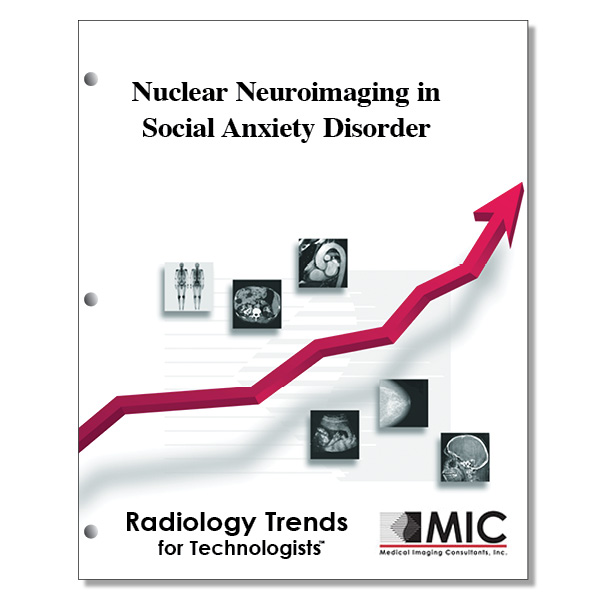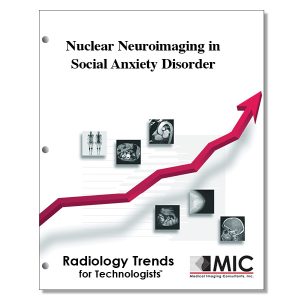

Nuclear Neuroimaging in Social Anxiety Disorder
A summary of nuclear neuroimaging as a complement to MRI-based experiments in investigating social anxiety disorder.
Course ID: Q00588 Category: Radiology Trends for Technologists Modalities: MRI, Nuclear Medicine, PET1.75 |
Satisfaction Guarantee |
$24.00
- Targeted CE
- Outline
- Objectives
Targeted CE per ARRT’s Discipline, Category, and Subcategory classification for enrollments starting after January 27, 2023:
[Note: Discipline-specific Targeted CE credits may be less than the total Category A credits approved for this course.]
Magnetic Resonance Imaging: 1.00
Procedures: 1.00
Neurological: 1.00
Nuclear Medicine Technology: 1.75
Procedures: 1.75
Other Imaging Procedures: 1.75
Registered Radiologist Assistant: 1.75
Procedures: 1.75
Neurological, Vascular, and Lymphatic Sections: 1.75
Outline
- Introduction
- Materials and Methods
- Results
- Surrogates of Neural Activity (Blood Flow, Perfusion, Metabolism
- Research into Functional Neurochemistry
- Discussion
- Conclusion
Objectives
Upon completion of this course, students will:
- know the characterization of the SAD condition discussed in this article
- know the regions of the brain that have been consistently highlighted as having hyperactivity by several reviews and metaanalyses
- be familiar with why some of the relevant literature was excluded from the discussion within this article
- know the classification groups of nuclear neuroimaging
- understand why meaningful appraisal of studies investigating surrogates of neural activity in SAD is challenging
- recognize the reason why the interpretation of both fMRI-based work and nuclear neuroimaging experiments can be problematic
- know why the knowledge of resting regional neuronal activity in SAD, which is provided largely by nuclear imaging experiments, is so important
- specify the biologically plausible regions in which resting state imaging studies provide evidence of disruptions
- know what can be added to nuclear imaging investigations of resting-state conditions to make it a more sensitive method in SAD characterization
- be familiar with the potential reasons why 15O-water PET studies are variable in SAD during symptom provocation
- know the brain regions in which various therapeutic interventions reduce rCBF
- know the findings of some nuclear imaging experiments of therapeutic interventions versus the findings of functional connectivity experiments that support the theory of the cingulate cortex’s role in modulating treatment effects
- be familiar with the results of post-therapy experiments investigating neural glucose metabolism in study participants with SAD
- be familiar with the studies on brain activity during task performance to assess the effects of therapy in SAD patients
- be familiar with the studies cited in the article that have investigated surrogates of neural activity in SAD participants compared to healthy controls
- be familiar with the studies cited in the article that have investigated surrogates of neural activity in SAD patients post-therapy compared to baseline
- know what nuclear neuroimaging studies using 11C-5-hydroxytryptophan suggest about serotonin synthesis rates
- be familiar with PET imaging of the serotonin transporter as a means of probing presynaptic serotonergic function
- recognize the findings of the only study to investigate postsynaptic serotonergic function in SAD
- know the reward system that normally drives social affiliation by way of personal social interaction, which SAD sufferers typically shun
- know the findings of SPECT studies targeting dopamine transporter (DAT) for presynaptic dopaminergic function in SAD participants
- be familiar with the findings of nuclear neuroimaging researching postsynaptic dopaminergic function in SAD participants
- be familiar with the findings of nuclear neuroimaging researching post-therapy dopaminergic function in SAD participants
- be aware of the PET neuroimaging study investigating substance P, and its possible binding to neurokinin-1 receptors in SAD, and its findings
- be familiar with the various PET and SPECT studies for neurotransmitter systems and proxies of regional neuronal activity
- know the important contributions which PET and SPECT imaging have made in SAD research
- identify the reasons why the knowledge of regional neuronal activity under baseline conditions is important
- understand why it is challenging to integrate the data obtained from nuclear imaging experiments investigating functional neurochemistry into biologic models of SAD
- know the neurotransmitters that have been identified as potentially important in anxiety, and specifically those that have been investigated in SAD
- identify the limbic and paralimbic structures which demonstrate high concentrations of Subtype 1A serotonergic receptors
- know which dopaminergic system receptors are excitatory and which are inhibitory
- be familiar with the clinical observations that have linked dopamine to SAD
- know on what condition, to date, nuclear imaging of neurotransmitter targets in SAD have been focused
- understand the new insights into SAD that have been provided by nuclear imaging
- know the benefit of the synchronous measurement capabilities of the newer hybrid PET/MRI systems
